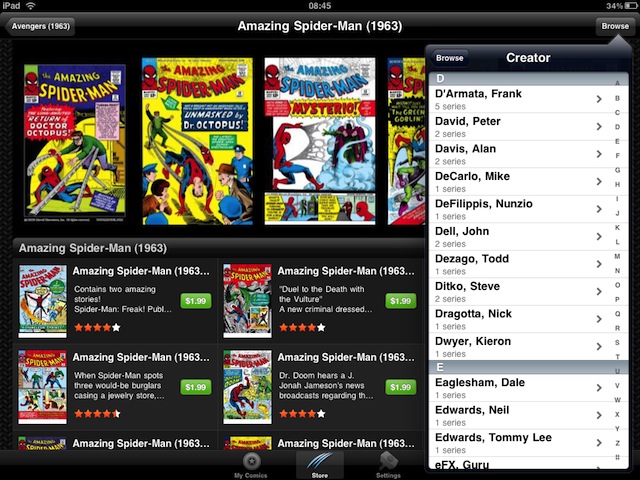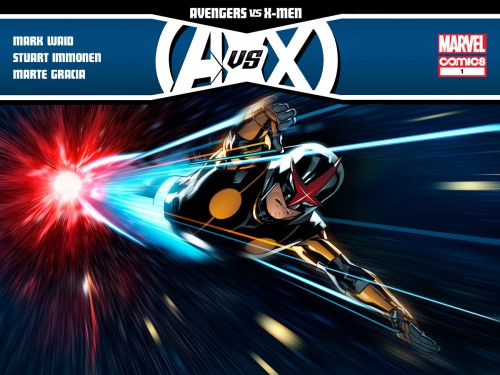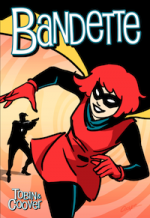The Complete Guide to Digital Comics (Part 1) How the iPad changed digital comics and the growth of ComiXology
 Digital comics are fast becoming as vital and exciting a part of the world of comics as traditional newsstand ‘floppies’. Taking up an estimated 15% of the comic market share in 2013 (according to both Image Comics and 2000ad) digital comics are taking over! At the heart of this digital revolution is the iPad and the undisputed king of digital comics apps, ComiXology’s Comics, we take a look at how these two came to dominate the digital comics landscape in the first part of our Complete Guide to Digital Comics.
Digital comics are fast becoming as vital and exciting a part of the world of comics as traditional newsstand ‘floppies’. Taking up an estimated 15% of the comic market share in 2013 (according to both Image Comics and 2000ad) digital comics are taking over! At the heart of this digital revolution is the iPad and the undisputed king of digital comics apps, ComiXology’s Comics, we take a look at how these two came to dominate the digital comics landscape in the first part of our Complete Guide to Digital Comics.
How the iPad launched the digital comics revolution
Although digital comics existed before the iPad (in the form of web comics and digital downloads of PDF and CBZ and CBR files) they weren’t actively supported by major publishers like Marvel and DC. So despite often being DRM free – meaning they were easily shared – it also meant they were easily pirated and the number of top titles weren’t there, making digital comics very much a niche product.
With the launch of the iPad in April 2010 everything changed for digital comics. Not only was Apple’s new 7.9 inch tablet the perfect medium for reading comics on, but thanks to the Marvel Comics app being part of the launch suite of app, the world’s biggest library of classic comics was now available at the tap of a screen, bringing digital comics to the mass market. As the iPad sales flourished so did the sale and growth of digital comics.

The company to succeed most out of this rise was ComiXology, creators of the top-grossing Comics app for iPad. Founded by David Steinberger, John Roberts, and Peter Jaffe ComiXology had a thriving online prescence as a web-based comics platform, but with the launch of the iPad came a whole new market for them to expand into. Initially this was in the role of software provider as the creators of the code behind the Marvel Comics app (as well as a host of others including Image, IDW Publishing and more.)
ComiXology’s Comics app and it’s siblings, offered fans a familliar storefront structure to buy and browse titles, along with a wealth of great titles from major publishers. In the early days this even included a DC Comics storefront within the Comics app! Although the number of titles available at the launch of the respective apps was not comprehensive, in time this would begin to change with more and more titles becoming available in increasingly better quality (keeping up with the iPad’s development ComiXology launched ComiXology HD to match the iPad’s new retina screen). Titles would soon become available at the same time as the printed predecessors – known in the trade as day and date publishing – offering fans a viable alternative to heading to the comic books tore every week, instead they could just download them onto their iPad. (And as of July 2009, to their iPhone too!)
Although other apps were available, such as iVerse’s Comics Plus, Panelfly and Graphicly, which offered a greater range of independent titles, not available on ComiXology at that time, it was Comics that would be come to dominate the market. Thanks to their huge library of titles that has continued to grow and grow, they have become one of the iPad’s top grossing apps of all time (regularly appearing in Apple’s Top 10 lists) and as ComiXology’s success has grown it has also allowed readers to synch titles across their iPad, iPhone and desktop PCs as well as now offering compatability with Google and Amazon tablets.
Read our guide to the top 5 digital comics apps for the iPad
How Guided View changed the landscape of digital comics
As well as the huge collection of titles available, one key area which allowed ComiXology to flourish was their patented Guided View technology for reading comics. Allowing fans to browse through comics at the tap of the screen as well as zooming in to read panel-by-panel, it means the reading experience is completely unlike reading a print title as readers can take in the story element by element getting even more involved with every moment.
Comic artists and writers have been quick to embrace this functionality as a new way to tell stories blurring the lines between comics and animation. Thanks to Guided View artwork can appear on screen in sequence rather than all at once on the page allowing the creators to guide their reader through the story at a different pace and with a more active experience making stories much more exciting. Some great early examples of creators trying this out include Alex de Campi’s Valentine and Kurt Christenson and Reilly Brown’s Powerplay, both of which helped to really set the stage for what was to come.

It was not long before the big names started seeing the potential of this new medium and in the summer of 2012 Marvel Comics unveiled their Infinite series of digital comics with Avengers vs X-Men: Nova. A tie-in to that years epic Avengers vs. X-Men crossover, this prequel to the series was low on dialogue but high on action, and showed off the true potential for the medium with sweeping intergalactic vistas and planet shaking action courtesy of artist Stuart Immonen. Marvel would continue producing one-off Infinite titles in 2012 and in 2013 they introduced their first ongoing series Wolverine: Japan’s Most Wanted.
Keen to get in on the action DC Comics subsequently released their own version of an ‘Infinite’ comic with Batman ’66 under their DC2 Interactive banner while ComiXology have in turn created their own genre of comics known as ‘Guided View Native’ which sees indie talents create amazing titles like Matthew Petz’s War of the Woods and Quinton Miles’ Template sit alongside the big boys from Marvel and DC, creating this unique brand of digital comic.
The godfathers of digital comics

When it comes to the development of mainstream comics there are two names who stand head and shoulder above the rest. The most high profile is Daredevil and Flash writer Mark Waid, who was the man behind the script of those first Infinite books. Waid had begun to develop his own experimental series of digital comics via his website Thrillbent, which began with the simple zombie series Luther and developed into his own series Insufferable with artist Peter Krause. He would go on to champion exciting new titles like Moth City and The Eighth Seal as well as working on high profile titles like Avengers vs. X-Men. His name value would help bring attention to digital comics and many of these titles would come to define the template for digital comics. However he could not have done it without with the assistance of layout artist Yves ‘Balak’ Bigerel.
The unsung hero of digital comics, Balak posted a short article on DeviantART in 2009 entitled ‘About Digital Comics’ which showcased the early potential for a hybrid of animation and comics that laid the ground work for the digital revolution. Balak has since helped Waid and co. create the ground work with Thrillbent and Marvel Infinite with ideas which are now common place ideas such as pull focuses, long sweeping panoramas and the sequential use of text. Preferring to keep a lower profile than Waid, Balak is every bit as important to the development of digital comics as his more high profile patron and is a true pioneer of digital comics!
Read our interview with Mark Waid discussing Infinite comics & Thrillbent
The wonderful world of MonkeyBrains and ComiXology Submit
By opening up the market to new creators to release titles we have seen a whole host of new digital-first publishers appear producing superb books which otherwise might not have seen the light of day. Even ComiXology themselves have dabbled with being a digital publisher releasing titles like David Gallaher and Steve Ellis’ Box 13 a title that was subsidised by ComiXology and became one of the first digital-first publications.

Other digital-first publishers would follow, most notably MonkeyBrain Comics who were launched in July 2012 by Chris Roberson and Allison Baker. Their debut featured 5 fantastically different titles from post-modern superhero Edison Rex, to all ages adventure Amelia Cole alongside sublime hand drawn fairytale Aesop’s Ark. Subsequently MonkeyBrain have developed a unique niche as the home of innovative and award-winning titles such as Masks and Mobsters (NY Times Comic of the Year 2012) and the Eisner award winning Bandette, as well as producing sublime one-shots like Kurt Busiek’s Thoughts on a Winter Morning. With many titles offered for the bargain price of £0.69/$0.99 it has allowed them to flourish without having to rely on a printing or distribution deal, so much so that many of these titles have since been released in print, reversing the traditional model for publishing.
With the boom in self publishing bringing more and more titles to the market, ComiXology helped aid this in 2013 with the advent of ComiXology Submit which allowed creators to easily upload titles to ComiXology and have them fitted to their Guided View format. Bringing a whole raft of new creator owned titles to the market place along with small scale offering from big name creators such as Becky Cloonan’s Demeter or Joshua Hale Fialkov’s The Bunker.
Read our interview with MonkeyBrain Comics founder Chris Roberson here!
ComiXology have helped to create a truly global market place for digital comics fans, but not everyone has embraced it. In the next instalment of our Complete Guide to Digital Comics we’ll look at those publishers who have used the iPad to create their own publishing platforms.
December 17, 2013 @ 6:06 pm
You’re so awesome! I don’t suppose I have read a single thing like
that before. So wonderful to find somebody with some unique thoughts on this
subject. Seriously.. thank you for starting this up.
This site is one thing that is required on the
web, someone with a bit of originality!